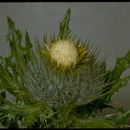Comments
(
anglais
)
fourni par eFloras
Cirsium brevistylum occurs in the coast ranges and adjacent coastal slope from southwestern British Columbia to southern California. In the Pacific Northwest its range extends inland to the northern Rocky Mountains of southern British Columbia, Idaho, and northwestern Montana, and the Blue and Wallowa ranges of eastern Oregon. It is absent from the central and southern Cascade Range.
In older literature the name Cirsium edule was widely misapplied to this species. A. Cronquist (1953) pointed out that the type of C. edule has corolla and style features quite different from those of the plants that had been called by that name and established the name C. brevistylum, based upon the notably short styles of this species. Hybrids of C. brevistylum with C. edule have been named C. ×vancouveriense R. J. Moore & C. Frankton.
- licence
- cc-by-nc-sa-3.0
- droit d’auteur
- Missouri Botanical Garden, 4344 Shaw Boulevard, St. Louis, MO, 63110 USA
Description
(
anglais
)
fourni par eFloras
Annuals or biennials, 20–350 cm; taprooted. Stems usually 1, erect, simple or branched in distal 1/2, loosely to densely villous or viscid-pilose with jointed trichomes, often arachnoid below heads; branches 0–many, ascending. Leaves: blades oblong to elliptic or oblanceolate, 15–35 × 2–10 cm, flat to ± undulate, coarsely dentate to shallowly pinnatifid, lobes broadly triangular, spinulose to spiny-dentate or shallowly lobed, main spines slender. 3–7 mm, abaxial faces thinly gray-tomentose, villous along major veins, sometimes glabrescent, adaxial sparsely villous or viscid-pilose along midveins with jointed trichomes; basal often absent at flowering, spiny winged-petiolate; principal cauline well distributed, gradually reduced, proximal winged-petiolate, mid and distal sessile, bases clasping or short-decurrent; distal moderately to strongly reduced, often spinier than the proximal. Heads 1–many, ± erect. usually crowded in subcapitate to tight corymbiform arrays, closely subtended by clustered ± leafy bracts. Peduncles 0–1(–30) cm. Involucres hemispheric to campanulate, 2.5–3.5 cm, 2.5–4 cm diam., loosely to densely arachnoid, phyllaries connected by long septate or non-septate trichomes. Phyllaries radiating in 5–10 series, subequal, green, linear-acicular, outermost margins sometimes spiny-fringed, otherwise all entire or minutely serrulate, abaxial faces without glutinous ridge; outer and mid bases short-appressed, apices stiffly radiating to ascending, long, very narrow, spines straight, slender, 3–5 m; apices of inner straight, flat. Corollas white to pink or purple, very slender, 20–25 mm, tubes 10–17 mm, throats 4–5 mm, lobes filiform with knoblike tips, 3–5 mm; style tips 2–4 mm, included or exserted (only 1–2 mm beyond corolla lobes. . Cypselae brown, 3–4.5 mm, apical collars stramineous, 0.2 mm; pappi 10–22 mm. 2n = 34.
- licence
- cc-by-nc-sa-3.0
- droit d’auteur
- Missouri Botanical Garden, 4344 Shaw Boulevard, St. Louis, MO, 63110 USA

